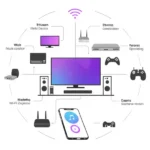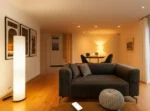Smart Home Media Center for the Whole House
Setting up a smart home media center with music in all rooms involves integrating various components to centralize your media and distribute audio seamlessly throughout your home. Here’s a breakdown of how to approach this project:
1. Define Your Needs and Budget:
- What kind of media will you access? (Music, movies, TV shows, photos)
- How many rooms do you want audio in?
- What is your budget? (This will influence your choices of equipment)
- What is your technical skill level? (Some solutions are more complex than others)
- Do you prefer wired or wireless speakers?
2. Core Components:
- Media Server: This is the central hub for your digital media. Options include:
- Dedicated Network Attached Storage (NAS) device: Excellent for storing large media libraries and running media server software.
- A computer (PC or Mac): Can be used as a server, especially if you already have one running.
- Software-based servers: Plex, Emby, and Jellyfin are popular choices that organize your media and stream it to various devices.
- Multi-Room Audio System: This is how you’ll get music to different rooms.
- Wireless Systems:
- Wi-Fi based: Sonos, Bose SoundTouch, and Denon HEOS are popular proprietary systems. They offer easy setup and good quality.
- Chromecast built-in/AirPlay 2: These technologies allow you to cast audio from your phone or computer to compatible speakers and receivers.
- Wired Systems:
- Multi-zone amplifier/receiver: A central unit that powers speakers in different zones (rooms) via speaker wires. Requires running wires through walls or ceilings.
- In-wall or in-ceiling speakers: Offer a clean, built-in look.
- Wireless Systems:
- Speakers: Choose speakers appropriate for each room and your desired audio quality. Options include:
- Wireless speakers: Easy to place, but require power outlets.
- Bookshelf or floorstanding speakers: Offer better audio quality but take up more space.
- In-wall or in-ceiling speakers: Discreet and save space.
- Soundbars: Good for living rooms and can offer virtual surround sound.
- Control Interface: How you’ll control your media and audio playback.
- Smartphone apps: Most multi-room audio systems and media servers have dedicated apps.
- Voice assistants: Integrate with smart speakers (Google Home, Amazon Echo) for voice control.
- Smart displays: Offer a visual interface for Browse media and controlling playback.
- Dedicated remotes: Some systems offer their own remotes.
- Networking Equipment: A robust home network is crucial for streaming media seamlessly.
- Router: A modern router with good bandwidth and coverage is essential.
- Network switch: May be needed if you have many wired devices.
- Ethernet cables: For wired connections (most reliable).
- Wi-Fi extenders or mesh network: To ensure good Wi-Fi coverage throughout your home.
3. Planning and Installation:
- Map out your speaker placement: Consider room acoustics and where you want sound.
- Decide on wired vs. wireless: If going wired, plan your cable runs before installation.
- Set up your media server: Install your chosen software (Plex, Emby, etc.) on your NAS or computer and point it to your media files.
- Install your multi-room audio system: Follow the manufacturer’s instructions for your chosen system. This may involve connecting speakers to an amplifier, setting up wireless speakers on your network, or configuring zones.
- Connect your components: Ensure your media server, audio system, and control devices are on the same network.
- Configure your control interface: Set up the apps, voice assistants, or remotes you’ll use to control your system.
4. Integration and Smart Home Features:
- Integrate streaming services: Most media servers and multi-room audio systems allow you to link your accounts for services like Spotify, Apple Music, Pandora, etc.
- Voice control: Connect your audio system to a voice assistant (Google Assistant, Alexa) to control playback with voice commands.
- Create scenes and automations: Use your smart home platform (if you have one) to create scenes that combine music playback with other smart home actions (e.g., “Movie Night” scene dims the lights and starts playing a movie with surround sound).
5. Tips for Optimization:
- Wired connections are generally more reliable for media streaming, especially for high-bandwidth content like 4K video.
- Ensure your Wi-Fi network is strong throughout your home if you’re using wireless speakers. A mesh network can help.
- Use a dedicated NAS for your media server if you have a large media library. This frees up your computer for other tasks.
- Organize your media library with consistent naming conventions and metadata for a better Browse experience.
- Regularly update your media server software and audio system firmware for new features and bug fixes.
Setting up a smart home media center with multi-room audio can be a rewarding project that enhances your home entertainment experience. By carefully planning and choosing the right components, you can create a seamless and enjoyable system for accessing and enjoying your media throughout your home.
Additional helpful information
How to monitor and control your smart home media network – Monitor and Control Your Media Smart Home Network
Set up a smart home lighting control center – Building Your Smart Home Lighting Control Center




